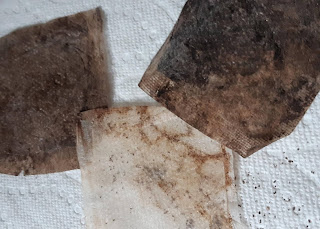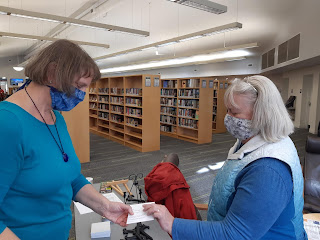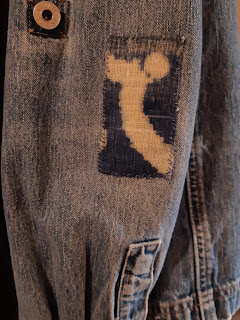I'm a tea drinker. And I love including used teabags in my fibre art. The versatility of the teabags - and the tea - is second to none. The colour is appealing and I like that I'm repurposing these little bags in which we steep our tea. What I didn't know until recently is that many teabags contain a bit of plastic, meaning they should not be composted after use. Some brands however are made from 100% fibrous plant material, including my preferred brand of Red Rose.
About 4 years ago, knowing I was saving teabags for my art after my tea had steeped, my husband came to me asking if I wanted the teabags that had gone through the compost. Many were not breaking down and others just a bit (perhaps due to the inclusion of plastics at that time?), and he had put several aside as he was spreading compost in the garden.
YES, I responded. Teabags that have been in the compost heap are enticing: rich - organic - saturated with colour. I could not have brewed such expressive tones through other means. My husband had no idea what I would use them for but seemed to instinctively know I might want them. Fast-forward 4 years, and he still rescues them from the compost for me. The teabags I use today have no plastic in them so we check on and collect them earlier from the composter than we used to, plus I now know I'm not adding any plastics to the pile.
"Some people will tell you there is a great deal of poetry and fine sentiment in a chest of tea.” – Ralph Waldo Emerson
These versatile teabags can be altered in so many ways:
- add hints of ink, natural inks, alcohol inks, watercolours
- sewn by hand or machine
- cut, folded, gathered, tucked
- bound like a book
- woven
- embellished with beading, writing, embroidery, tiny paintings
- heat distressed
- composted for a richer colour
- and the tea grounds are also useful for creating an aged look on paper and fabric, and when eco-printing. The grounds are, thankfully, compostable.
Teabags can make an appetizing element in a design and strengthen a composition. Here are some ways I've infused them in my fibre art:
I first used these compost coloured teabags as the windows in a three dimensional vacant factory building I constructed from cardboard and on which I painted, stitched, and added a bit of collage. The teabags perfectly represented the grimy windows on these old, neglected buildings. And when I began heat distressing some parts of the walls with a heat gun, and accidently made a hole in one of the "windows", I realized it looked just like a broken pane of glass. A couple more "accidents" completed the look I was seeking.

Preparing used teabags for use:
I use mostly Red Rose brand teabags which do break down in the compost heap. Brands that have plastic in them should not be put through the composter. Depending where you live they can either be sent to commercial composters, thrown out or, better yet, incorporated into your art.
- If composting, collect the teabags from the compost before they have broken down.
- After steeping or removing from the composter, allow the teabags to air dry.
- Slit or cut close to one edge and remove the tea grounds. Tea grounds of course are compostable, or can be reused in other art projects or when eco-dyeing.
- Iron the now empty teabag between 2 layers of parchment.
- Store in an airtight container until ready to use.
"Each cup of tea represents an imaginary voyage.” – Catherine Douzel



















































